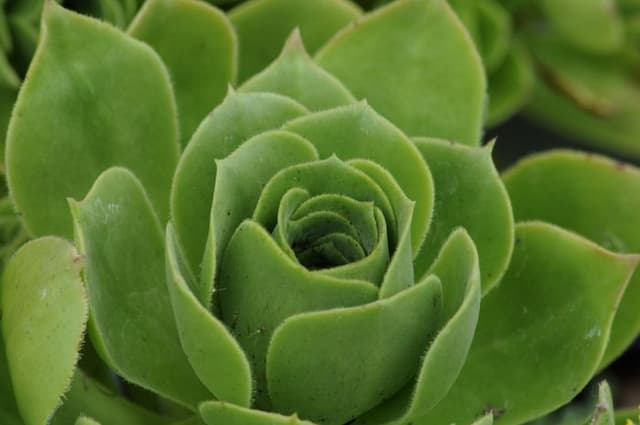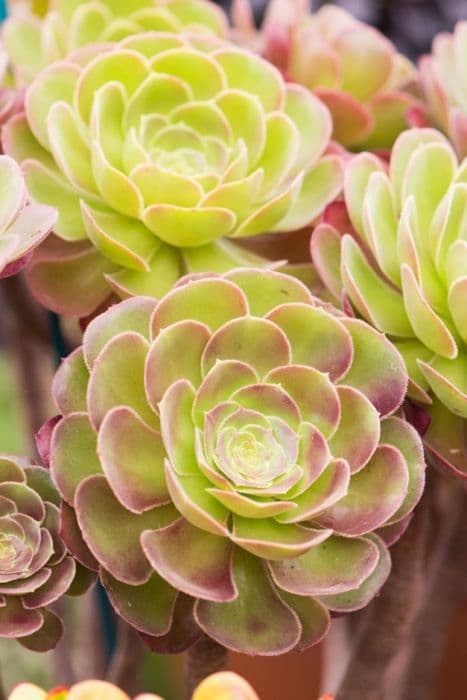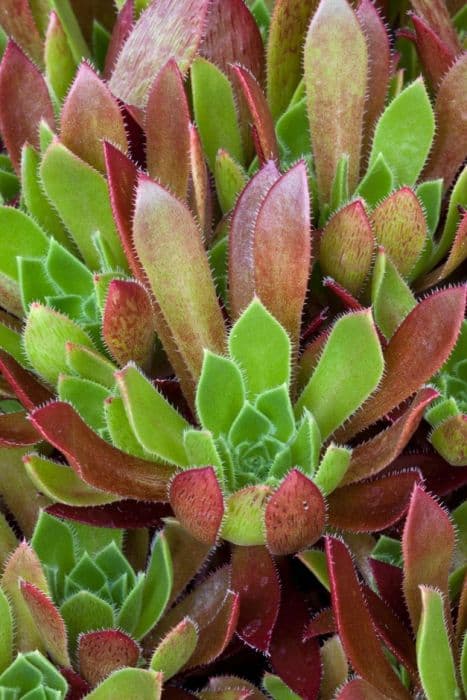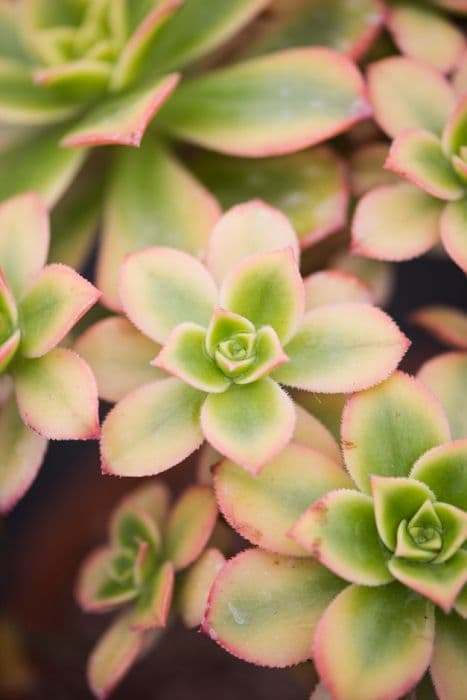Lavender Pebbles Graptopetalum amethystinum

ABOUT
Commonly known as Lavender Pebbles or Jewel-leaf Plant, this succulent presents a unique and attractive appearance. The leaves are the most striking feature, with a rounded, pebble-like shape that gives it a soft, almost pillowy look. Each leaf is a blend of pastel green and pinkish-lavender hues, which can become more intense when the plant is exposed to sunlight, stressing the leaves into developing a deeper tone. This coloration resembles the semi-precious stone amethyst, hence the name Lavender Pebbles. The leaves are arranged in small, compact rosettes that appear to spiral out from the center, creating a symmetrical and organized pattern. This arrangement allows the plant to maximize water catchment in its native habitat. The texture of the leaves is waxy and plump, characteristic of succulents that store water to survive in dry, arid conditions. The surface is usually smooth with a slightly powdery finish known as a bloom, which further enhances the pastel effect. The Lavender Pebbles are often found forming clusters, with multiple rosettes growing in close proximity, which creates a lush and full appearance. This clustering habit makes it an excellent choice for ground cover in suitable climates, or as a striking feature in rock gardens, potted arrangements, or as part of a succulent collection. It can also occasionally produce small, star-shaped flowers, typically in the spring, which add an additional layer of interest to this already charming plant. The blossoms are often a pale color, which complements the lavender hues of the foliage.
About this plant
 Names
NamesSynonyms
Lavender Pebbles, Amethyst Rosette
Common names
Graptopetalum amethystinum
 Toxicity
ToxicityTo humans
Lavender Pebbles or Graptopetalum amethystinum is not known for being toxic to humans. Generally, ingesting parts of this succulent plant does not result in poisoning or severe consequences for most people. However, as with any non-food plant, individual reactions can vary, and it's always best to avoid eating plants that are not meant for consumption.
To pets
Lavender Pebbles or Graptopetalum amethystinum is also not known for being toxic to pets. It is considered to be non-toxic to cats and dogs, so ingesting this plant typically should not result in poisoning or severe health consequences. Nevertheless, it is always prudent to prevent pets from eating ornamental plants as they might cause gastrointestinal discomfort or other mild reactions in certain pets.
 Characteristics
CharacteristicsLife cycle
Perennials
Foliage type
Evergreen
Color of leaves
Lavender
Flower color
Yellow
Height
6 inches (15 cm)
Spread
24 inches (61 cm)
Plant type
Succulent
Hardiness zones
9
Native area
Mexico
Benefits
 General Benefits
General Benefits- Easy to Care For - Graptopetalum amethystinum, also known as Lavender Pebbles, is a low-maintenance succulent suitable for beginners.
- Drought-Tolerant - It is well adapted to dry environments, requiring minimal watering and conserving resources.
- Aesthetic Appeal - With its unique lavender hue and rosette shape, it adds striking visual interest to gardens and indoor spaces.
- Propagation Ease - Lavender Pebbles can be easily propagated from leaves and cuttings, making it ideal for sharing with friends or expanding your collection.
- Versatile - This plant is suitable for various settings, including rock gardens, container gardens, and as a part of succulent arrangements.
- Stress Indicator - The coloration of Lavender Pebbles can change with temperature and sunlight, serving as a natural indicator of environmental conditions.
 Medical Properties
Medical PropertiesThis plant is not used for medical purposes.
 Air-purifying Qualities
Air-purifying QualitiesThis plant is not specifically known for air purifying qualities.
 Other Uses
Other Uses- As a natural dye: The leaves of the Graptopetalum amethystinum, also known as Lavender Pebbles, can be used to produce a subtle dye for fabrics, imparting a gentle, earthy tone.
- Photography props: Due to their unique shape and color, Lavender Pebbles can be used to add an interesting visual element to macro or still life photography.
- Artistic inspiration: Artists may draw inspiration from the structural form and hue of Lavender Pebbles for design elements in paintings or textile patterns.
- Educational tool: Lavender Pebbles can be used in botanical studies and classrooms to teach about succulent plant adaptations and care.
- Wedding decorations: These plants can serve as long-lasting and unique table centerpieces or bouquet additions for weddings and other events.
- Bonsai arrangements: Lavender Pebbles can be incorporated into miniature bonsai gardens due to their slow-growing nature and attractive appearance.
- Theme gardens: Lavender Pebbles can be a focal point in a purple-themed garden or a rock garden for aesthetic diversity.
- Culinary garnish: While not commonly eaten, the non-toxic leaves may be used as an ornamental garnish for plating in high-end culinary dishes.
- Feng shui element: The plant can be placed in specific areas of a home or office as a feng shui cure to balance energy and bring a calming presence.
- Gifts and favors: Potted Lavender Pebbles can be used as eco-friendly and low-maintenance party favors or gifts for friends and family.
Interesting Facts
 Feng Shui
Feng ShuiThe Lavender Pebbles is not used in Feng Shui practice.
 Zodiac Sign Compitability
Zodiac Sign CompitabilityThe Lavender Pebbles is not used in astrology practice.
 Plant Symbolism
Plant Symbolism- Beauty and Uniqueness: Often referred to as Lavender Pebbles or Amethyst Pebbles, Graptopetalum amethystinum's rosettes and pearl-like appearance symbolize the beauty and uniqueness in nature, reminding us to appreciate the diverse forms of beauty around us.
- Resilience and Adaptability: As a succulent, the Lavender Pebbles epitomize resilience and adaptability, thriving in rocky and arid conditions which echoes the plant’s ability to prosper in challenging environments and adapt to less-than-ideal circumstances.
- Mystery and Wonder: The plant's amethyst-like color and its transformation under stress conditions, where it can change shades, embody mystery and wonder, encouraging observers to find intrigue in the natural world's adaptive capabilities.
- Healing and Soothing: The association of its amethyst-like color with peace, calm, and healing in various cultures symbolizes the plant’s presumed potential to bring about soothing and restorative energy to its surroundings.
 Water
WaterThe Lavender Pebbles, commonly known as Graptopetalum amethystinum, should be watered deeply but infrequently, allowing the soil to fully dry out between waterings. Typically, watering once every two weeks is sufficient. However, during the hot summer months, increase watering to once a week. To water this succulent, pour approximately 8 ounces of water directly onto the soil near the base of the plant. Be cautious not to overwater as this can lead to root rot; always use a pot with drainage holes.
 Light
LightThe Lavender Pebbles prefers bright, indirect sunlight and should be placed in a location that receives plenty of light throughout the day without being exposed to harsh, direct sun. An east or west-facing windowsill is ideal as it provides the plant with gentle morning or evening sun. Avoid placing it in deep shade or full afternoon sunlight to prevent scorching.
 Temperature
TemperatureThe Lavender Pebbles thrives in temperatures between 60 to 80 degrees Fahrenheit and can withstand temperatures down to about 40 degrees Fahrenheit but not for prolonged periods. It should be kept away from drafty windows and doors during cooler months and provided with warmth during the growing season for optimal growth. Avoid exposure to temperatures over 90 degrees Fahrenheit as it may stress the plant.
 Pruning
PruningPruning the Lavender Pebbles is mainly for aesthetic purposes and to remove any damaged or dead leaves. It can be done at any time of year but is best performed in the spring, which is the start of its active growing season. Prune sparingly, only cutting away parts that are unsightly or unhealthy. Doing so can encourage healthier growth and maintain the plant's compact shape.
 Cleaning
CleaningAs needed
 Soil
SoilLavender Pebbles require well-draining soil with a mix of potting soil, coarse sand, and perlite or pumice. The ideal pH for Lavender Pebbles ranges from 6.0 to 7.5, slightly acidic to neutral.
 Repotting
RepottingLavender Pebbles should be repotted every two to three years or when they outgrow their current container.
 Humidity & Misting
Humidity & MistingLavender Pebbles thrive in dry to average humidity levels, typical for indoor environments, and do not require high humidity.
 Suitable locations
Suitable locationsIndoor
Place Lavender Pebbles in bright, indirect light and avoid overwatering.
Outdoor
Grow Lavender Pebbles in full sun to partial shade and ensure good drainage.
Hardiness zone
9-11 USDA.
 Life cycle
Life cycleGraptopetalum amethystinum, commonly known as Lavender Pebbles or Jewel-Leaf Plant, begins its life cycle as a seed, which germinates in well-draining soil with adequate warmth and light. The seedling phase follows, where its succulent leaves start to develop their characteristic fleshy appearance along with a rosette pattern. As it enters the vegetative stage, the Lavender Pebbles experiences rapid leaf growth and may produce offsets as a form of asexual reproduction. During its flowering stage, the plant produces star-shaped flowers, typically in the spring, which are pollinated by insects, leading to the production of seeds. After pollination and seed set, the plant may enter a dormant phase, particularly in cooler months when growth slows down. Throughout its life, the Lavender Pebbles requires minimal water due to its succulent nature, and can live for many years with proper care, completing its life cycle multiple times.
 Propogation
PropogationPropogation time
Spring-Early Summer
Graptopetalum amethystinum, commonly known as Lavender Pebbles, is propagated most effectively in its active growth period, usually from spring to early autumn. The most popular method involves leaf cuttings, where a healthy leaf is gently twisted off the plant, ensuring a clean break. After removal, the leaf is left to callous over for a few days to prevent rot when planted. The calloused cutting is then placed on well-draining soil, without burying it, in a shaded spot to avoid direct sunlight. Over the course of several weeks, the leaf will begin to root and eventually produce a new Lavender Pebbles plant, as long as the soil is kept slightly moist but not waterlogged.









